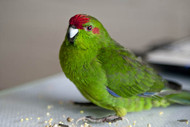Kakariki Fact Sheet
Posted by Kakariki Facts, Kakariki Parrots, Kakariki Breeding on 11/4/2013
Rosemary Low explains more about the Kakariki Parrot.
Scientific Name
The scientific name of the Kakariki is the Cyanoramphus novaezelandiae (Red-fronted), Cyanoramphus auriceps (Yellow-fronted)
Adult Length
25-28cm.
Adult Weight
Approximately 65g.
Potential Lifespan
15-20 years.
Origin
New Zealand. Formerly abundant on the mainland, the Red-fronted is now virtually extinct there. Populations survive on Stewart Island and surrounding islands, Kapiti Island, the Kermadec Islands, some Hauraki Gulf islands, Chatham Islands, Snares and Antipodes Islands. The Yellow-fronted exists on the mainland (North and South Islands) and Stewart Islands but is uncommon.
For everything you need for your Kakariki please click here.
Kakariki status in wild
Red-fronted: Vulnerable, due to extensive loss of habitat and greatly decreased numbers.
Yellow-fronted: Near-threatened but predator control and habitat recovery could result in improved status.
Conservation
Common only several decades ago, numbers of both species have crashed. Now small offshore islands that have been cleared of predators are their only habitats. In 2008 I had the pleasure of watching these birds in the wild, their colours so vibrant as the sun lit up their plumage, and as they flew, close to the ocean, calling their ee-ee-ee contact notes.
I was on the island of Tiritiri Matangi in the Hauraki Gulf, not far off the coast of Auckland. My heart soared as I watched them flying, perching and preening. They seemed to me larger and more solid-looking than the captive birds we know. They looked so beautiful with their ruby-red eyes!
The story of this population is an interesting one. The island?s 220 hectares were originally covered with forests of native trees. After centuries of Maori occupation and farming by Europeans, hardly any forest had survived and most native birds, including the Kakariki, had gone, their disappearance assisted by introduced cats, stoats and rats.
In the Aviary
Extremely active and very inquisitive, Kakarikis are wonderful aviary birds. Inexpensive and free-breeding, they are very popular -- even more so since various mutations have been available. The aviary must be very secure with double doors because Kakarikis are lightening fast in their reactions, also very friendly and fearless, so escape could happen all too easily.
The aviary must be very safe with nothing that is potentially hazardous. Kakarikis are enthusiastic bathers so fresh water in a large shallow container must always be available. Because they are so active and such strong flyers, Kakarikis are best kept in an aviary no less than 4.5m (15ft) in length. They love to forage so will enjoy life in a large planted aviary, where they can be kept with small softbills and Finches.
For lots of Kakarki cages please click here.
Kakariki Vocalisations
Their calls are not loud or unattractive thus they are ideal for people with close neighbours who might complain about noisier birds.
Kakariki Breeding
The clutch size is large -- five to nine eggs, which are incubated by the female for 19 days. Young spend about five weeks in the nest. Kakarikis are such good parents that they are often used as foster parents by breeders of Australian Parakeets.
Kakariki Diet
Dry and sprouted seeds should form the basis of the diet. Kakarikis should be offered a good quality Parakeet mixture containing some sunflower and safflower, plus sprouted sunflower and mung beans, which can be sprouted together. Millet sprays are enjoyed. They will also eat fruit, such as apple, strawberries and grapes, also sweetcorn, carrot and celery.
Wild foods such as seeding grasses and the young leaves of dandelion and smooth sow-thistle are also relished. Cultivated greens such as kale, rocket and spinach will also be eaten -- but they are not fussy and will eat almost any green food which should be fed daily . Eggfood (crumbly consistency) should be offered just before chicks hatch and during the rearing period.
Note that Kakarikis have a habit of scratching rapidly with their feet, sometimes scattering the contents of the food dish in all directions. One breeder overcame this problem by placing food dishes inside much larger containers -- but this would prevent the use of swing feeders and some feeding shelves.
This habit originates from their natural foraging behaviour: they feed on the ground as well as in trees and shrubs. On the ground they scratch in leaf litter, rapidly pushing it aside with their feet in their search for edible items. In a huge, landscaped aviary at Auckland Zoo, I was fascinated to observe this behaviour.
For lots of Kakariki food please click here.
If you have enjoyed this article or have any thoughts, please leave your comments for others below...
For everything you need for your Kakariki please click here.

